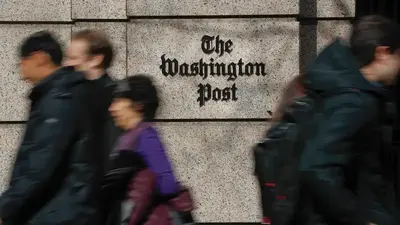Business
Bank turmoil led Fed officials to forecast fewer rate hikes
WASHINGTON -- Turmoil in the banking system after two major banks collapsed led many Federal Reserve officials to envision fewer rate increases this year out of concern that banks will reduce their lending and weaken the economy.
The heightened uncertainty surrounding the banking sector also helped Fed officials coalesce around their decision to raise their benchmark rate by just a quarter-point, rather than a half-point, at their meeting March 21-22, according to the meeting minutes.
The Fed also revealed Wednesday that its staff economists have forecast that a pullback in bank lending will cause a “mild recession” starting later this year. That is a shift from their previous estimates, which had predicted that the economy would eke out positive growth this year. If the impact of the banking turmoil ends up being less than economists' forecasts, a recession might be avoided, the minutes suggested.
Overall, the minutes showed that the banking troubles have injected significant uncertainty into the Fed’s decision-making and reversed an emerging trend to keep raising rates aggressively to quell inflation. At their meeting last month, Fed officials projected that they will raise their benchmark short-term rate — which affects many consumer and Business loans — just once more this year, in May.
Fed officials who spoke this week have also emphasized the importance of monitoring bank lending. There are already reports of small companies struggling to obtain loans, though it's not yet clear how widespread the impact will be.
Before the collapse of Silicon Valley Bank, many Fed officials had said they expected to forecast more than one additional hike this year because economic and inflation data showed that they still had more to do to control the pace of price increases. But according to the minutes of last month's meeting, Fed officials agreed that the collapse of the two large banks “would likely lead to some weakening of credit conditions,” as banks sought to preserve capital by curtailing lending to consumers and businesses.
Several officials said they had considered supporting leaving rates unchanged at last month's meeting. But they added that actions by the Fed, the Treasury Department and the Federal Deposit Insurance Corp. to protect depositors had “helped calm conditions” in banking and reduced the risks to the economy in the short run.
Some other officials said they had favored a half-point hike last month because hiring, consumer spending, and inflation data still pointed to a hot economy. But given the uncertainty resulting from the banking troubles, they “judged it prudent” to implement a smaller quarter-point increase.
Also Wednesday, the government's latest inflation data showed that price increases are slowing but remain far above the Fed's 2% inflation target, making another quarter-point rise in its benchmark rate highly likely at its meeting next month.
Consumer prices were up 5% in March compared with year ago, much less than the 6% year-over-year increase in February. But excluding volatile food and energy costs, core inflation ticked higher — from 5.5% to 5.6%. Economists consider core prices a better read on underlying inflation.
Fed officials who have spoken this week have suggested that they will need to raise their key short-term rate for a 10th time in May. Economists outside the Fed increasingly expect the Fed to pause its rate hikes after that.
Mary Daly, president of the Federal Reserve Bank of San Francisco, said Wednesday that the March inflation report was “good news” but that price increases are “still elevated.”
“The strength of the economy and the elevated readings on inflation," Daly said, “suggest that there is more work to do.”
Yet she also suggested that the Fed's forthcoming rate decisions will hinge, in part, on how severely banks restrain lending.
“How much does that put the brakes on the economy so that we don’t have to tighten more?” Daly asked. “We don’t know the answer, but it’s one of the things we’ll focus on.”
The San Francisco Fed was the principal federal regulator for Santa Clara, California-based Silicon Valley Bank, whose collapse a month ago ignited financial turmoil in the United States and Europe. Daly declined to comment on the issue.
Tom Barkin, head of the Federal Reserve Bank of Richmond, said on CNBC that the March inflation report showed that core inflation was still too high.
“There’s still more to do, I think, to get core inflation back down to where we’d like it to be," he said.
Austan Goolsbee, who became president of the Chicago Fed early this year, sounded a more cautious note this week. Goolsbee noted that stress in the banking system can weaken the economy and could mean that the Fed might not have to raise rates as much as it otherwise would.
“I think we need to be cautious,” he said. “We should gather further data and be careful about raising rates too aggressively until we see how much work the headwinds are doing for us in getting down inflation.”
Goolsbee did not say explicitly whether he supported another rate increase. Goolsbee, Daly and Barkin are among the Fed's 18 policymakers, although only Goolsbee currently has a vote on rate decisions. The Fed's regional presidents vote on a rotating basis.
-

 Business8h ago
Business8h agoNew Information: These HV Big Lots Are Now Staying Open
-

 Business8h ago
Business8h agoBrush Fire Rages On Near Butternut In Great Barrington, MA
-

 Business18h ago
Business18h agoU.S. Antitrust Regulators Seek to Break Up Google, Force Sale of Chrome Browser
-

 Business18h ago
Business18h agoSuccessful White Men Alone Can’t Create America’s Economic Future
-

 Business1d ago
Business1d agoThe Rise of Silent Services
-

 Business1d ago
Business1d agoTim Latimer
-

 Business2d ago
Business2d agoCarbon offsets can help bring energy efficiency to low-income Americans − our Nashville data shows it could be a win for everyone
-

 Business2d ago
Business2d agoWorkplace diversity training programs are everywhere, but their effectiveness varies widely



























